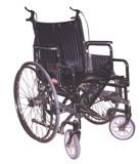Stage 7 — Production Planning & Preparation
Determine final manufacturing processes pricing and marketing strategies, and test launch activities.
Steps 7.1 through 7.13
To view supporting evidence, click on magnifying glass icons or hyperlink text.
Click on the toolbox images to view tools related to each step.
Click on the UpStop Wheelchair Braking System image to review an example of the steps in this stage.
Step 7.1
Draft preliminary bill of materials and create assembly structure overview.
Step 7.2
Develop materials plan including materials and lead times.
Step 7.3
Estimate market needs and cost for production.
Generate detailed list of manufacturing operations (routers) for production process.
Step 7.4
Develop production and capacity plan.
Step 7.5
Plan and schedule engineering design for scale-up production.
Utilize material requirements planning system to ensure adequate inventory of raw materials needed for manufacturing will be available.
Add engineering design to bill of materials as lowest level item.
Create a router showing where engineering is needed.
Review high-risk areas in design and create alternatives as needed.
Step 7.6
Plan and schedule tool and process design.
Identify need for new tooling (jigs/fixtures) or manufacturing processes.
Add tooling and equipment requirements to bill of materials.
Create routers for completing tool design ad process implementation.
Step 7.7
Review costs using preliminary bill of materials.
Determine if changes to bill of materials are required based on production process requirements.
Step 7.8
Review IP protection and obtain final approval from regulatory and reimbursement agencies — as needed.
Begin 501(k) pre-market approval with FDA or other means of demonstrating safety and effectiveness as required.
Step 7.9
Finalize distribution logistics.
Deploying physical product requires inventory for point of sale, sales rep demonstration and re-stocking through distribution network.
Step 7.10
Finalize marketing and sales plans.
Choose name (trademark) for product.
Create user manuals & marketing literature.
Identify/manage packaging and service requirements.
Identify roll out strategy/pricing schedule.
Negotiate final terms with distributor network.
Step 7.11
Generate post-launch evaluation plan.
Determine how best to maintain contact with customers post-sale to obtain feedback.
Step 7.12
Initiate trial/limited production runs.
Set numbers to provide valid and reliable feedback.
Step 7.13
Test market and/or trial sell product.
Timely opportunity to revisit Stage 2. Scoping activities to detect changes in the market conditions (positive or negative), and assess any potentially competing products or disruptive technologies arising in the interim.
Decision Gate 7
Go to Product Launch? Proceed to Commercial Product deployment if the financial projections and logistical plans support continuation, and the Stage 2 Scoping remains valid. The decision to continue involves higher resource and longer time commitments — and higher risk — than all prior Stages.




























